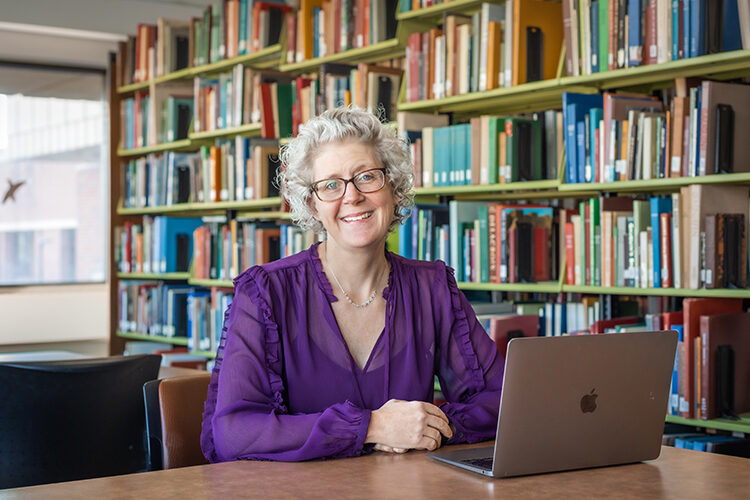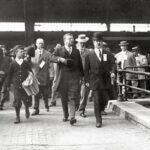A hundred years ago, the city of Charleston, S.C., came up with a plan to revive its economy, which had been sagging since Reconstruction. Tapping into its antebellum past to charm visitors was a simple idea, but the city’s elite not only left out the uncomfortable parts of the city’s long slave history, they took it a step further: They rewrote the city’s public memory.
While it happened in many Southern cities, Charleston was a particularly striking example of how lucrative and enduring the strategy was, said Shevaun Watson, an associate professor of English at UWM. More than 7 million tourists visit the small downtown area annually, generating $8 billion a year by 2018.
Watson is writing a book about the ways that collective memory was formed – and defiled – in the city as it seized a romanticized version of its past to sell to tourists. The intersection of public memory and the notion of cultural heritage has always intrigued Watson, who specializes in rhetoric – how language is used to construct meaning.
While the intent in Charleston was never to show history accurately, Watson wondered what the broad effect of this revisionist history has had since it is sold through tourism to millions of people each year.
The quaint Old South version of Charleston that the city created and marketed was white-washed and it was done using racist tropes that promoted misinformation. Another result was that tourism helped the elite bypass public deliberation about the city’s historic architecture and its downtown neighborhoods through historic district zoning ordinances.
In this conversation, Watson talks more about the co-evolution of “heritage tourism” and historical preservation in Charleston – and how her field of rhetoric figures into it.
How is heritage different from history?
I think it’s really interesting how heritage is tied to identity claims in a way that history isn’t. In fact, I would define heritage as history that is made to be visited. So it’s the making of it to me, as a rhetoric scholar, that’s the interesting part. Heritage isn’t as connected to all of those historical archival details. It’s a less complicated representation to visit.
I’ve always been really interested in studying history through a rhetorical lens considering the way that histories can be very different and the way they are told can be very persuasive.
What are some of the ways Charleston portrayed itself to attract visitors?
A mainstay of its travel boosterism were images of Southern aristocracy. The South was, to some, the last stronghold of a unified American upper class. It offered outsiders the opportunities to touch patrician splendor, a fantasy for tourists that remains incredibly strong today.
Visitor comfort was commodified through racist stereotypes of the formerly enslaved. African Americans were turned into attractions themselves, being made to appear non-threatening, hardworking and happy. All of these images deeply shaped how outsiders perceive the South. For many tourists, this is the most they will hear about Charleston’s history.
What are other negative effects of this flawed storytelling?
The development of tourism in Charleston played a role in the unequal distribution of land, property and memory for African Americans living there.
Of course, no mention was made of the deep traditions, vibrant communities and myriad achievements of enslaved and free Blacks. Elite white cultural producers have ignored the city’s ethnic and racial diversity and erased the most violent realities of its slave-owning past and Jim Crow present.
Tourism also normalized racial segregation while making African Americans “safe” for consumerist consumption. The proliferation of demeaning, sentimentalized stereotypes, often in caricatured forms, magnified a sense of racial inferiority.
There hasn’t been an equal distribution of the wealth gained: Black and brown people did – and still do – the majority of physical labor and at very low wages to create the seamless spaces of comfort for tourists.
How was historic preservation used to reshape Charleston’s neighborhoods – both Black and white?
The 1931 Zoning Ordinance explicitly ties the general welfare of the city to the preservation of its historic places by creating a special zone – the country’s first historic district.
In 1960, the last African American property owners left an area that had long been a predominantly Black, middle- and working-class neighborhood called Ansonborough. They moved because, if they hadn’t, they would have come under the protective covenants of the historic district and the ordinances of the Board of Architectural Review. And they could not afford the restrictions and upkeep.
In this way, the city radically altered the racial makeup of the neighborhoods near downtown. Once two-thirds Black, the Charleston peninsula became more than three-quarters white.
Now exceptionally wealthy, Ansonborough isn’t just any story of gentrification. The economic mechanics behind it served as a model for similar kinds of neighborhood revitalization in hundreds of American communities thereafter.
Most of the property on the peninsula now is owned privately. Why is that important?
Because the city’s Board of Architectural Review with its broad powers, hundreds of homes fall under some historic designation and so private homeowners, not the historical societies, become implicated in historic preservation and all of its problematic effects.
Conveniently, using houses to memorialize a romanticized version of the slave South requires no allocation of public funds and no public deliberation about who or what should be remembered of Charleston’s history. Instead, preservationists repurposed whole parts of existing built environments for their own memorial ends.
Because of the zoning model Charleston created, private spaces of white elites became the public spaces of Charleston’s collective memory and “official” heritage.







